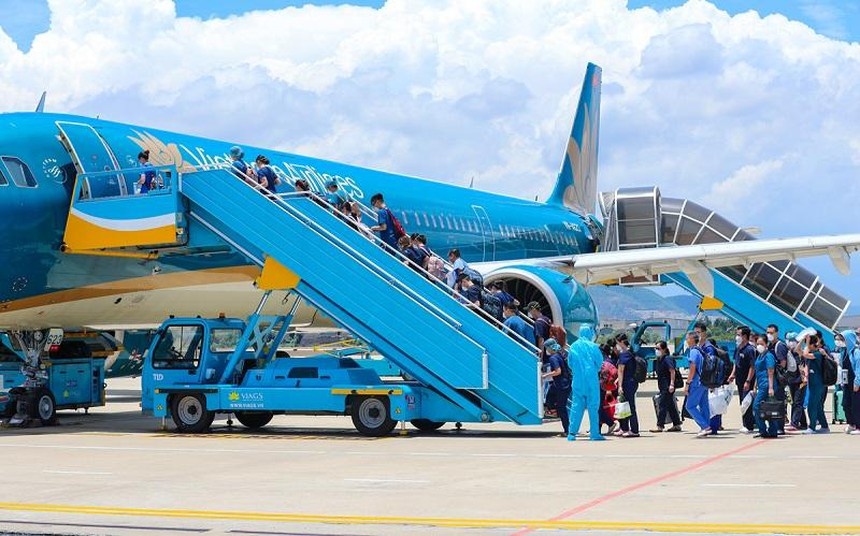Proposal tabled to resume stage-based normal aviation transport in local routes
 |
| The airlines currently mainly engage in transporting cargoes and limited passenger groups for pandemic prevention |
The move aims to carry out the dual task of ensuring pandemic prevention and maintaining passenger transport as usual as several localities have achieved optimistic results in pandemic containment through stiffer social distancing measures.
As of now, the airlines have just engaged in transporting cargoes and certain groups of passengers such as officials on duty, pandemic prevention forces, and those with approved documents for movement granted by relevant localities.
Under the proposal, existing airports offering general aviation transport services are divided into three groups (A, B and C) based on the localities accommodating these airport venues.
Group A airports are located in centrally-governed cities and provinces not applying social distancing policies under Directive 16.
Group B airports are situated in centrally-governed cities and provinces which only apply social distancing in specific district-level areas.
Group C airports are located in centrally-controlled cities and provinces currently fully applying social distancing measures.
| The CAAV mandates the local airlines to review their resources (airplanes, crew members, repair and maintenance capacity, etc) to ensure operating flights attuned with approved plans. |
The first phase of the trial would run for four weeks. During this period, flights from group A airports to airports of any other group have no passenger limit, and all passengers must possess negative COVID-19 test certificates taken within 72 hours before the flight.
For flights from group B airports to any other and from group C airports to group A and B airports, if the passengers are on-duty officials or belong to pandemic prevention forces, they only need to possess a negative COVID-19 test certificate taken within 72 hours before the flight.
Other passengers must have similar certificates, in addition to meeting one of the following conditions: having a certificate on quarantine completion and being transported by specialised cars from quarantine units directly to the airport of departure; having certificate of receiving completion of two shots of COVID-19 vaccines in which the second shot was completed at least 14 days and no more than 12 months before the date of departure; or having a certificate on COVID-19 recovery no more than 12 months before the date of departure.
Flights between group C airports can only transport on-duty officials, members of pandemic prevention forces, and passengers having documents allowing travel or accepting entrance by relevant localities. All these passengers must have negative COVID-19 test certificates taken within 72 hours before the flight.
During this trial period, the airlines will only be able to sell tickets for flights departing within four weeks of the date the Ministry of Transport (MoT) greenlit the plan.
The Civil Aviation Authority of Vietnam (CAAV) would keep close eyes on the process to draw practical assessments.
If the first phase of the trial goes smoothly, the second phase will be launched with almost nearly similar requirements for continuity.
During the second phase of the trial, the airlines will only be able to sell tickets to passengers with a certificate on living in areas not applying social distancing under Directive 16 for flights departing within four weeks of the start of the second phase.
After the second phase, the airlines will be able to sell tickets as usual unless they receive directions otherwise.
What the stars mean:
★ Poor ★ ★ Promising ★★★ Good ★★★★ Very good ★★★★★ Exceptional
Related Contents
Latest News
More News
- The destinations powering Vietnam’s festive season travel demand (December 04, 2025 | 18:33)
- Vietnam named among the world’s most exciting winter destinations (December 04, 2025 | 15:10)
- Phu Tho emerges as northern Vietnam’s new tourism hub (December 01, 2025 | 17:00)
- Vietjet completes Airbus A320/A321 updates ahead of deadline (December 01, 2025 | 09:49)
- Vietjet resumes Con Dao flights from early December (November 28, 2025 | 15:24)
- Free tickets, Lunar New Year promotions on offer at Vietjet Mega Livestream (November 26, 2025 | 15:32)
- Scandinavian Airlines and Vietnam Airlines broaden agreement with new routes (November 25, 2025 | 17:04)
- Halong Cruise Port welcomes over 3,100 international visitors (November 12, 2025 | 18:06)
- Vietnam.travel climbs to second place in Southeast Asia website rankings (November 12, 2025 | 18:01)
- Cat Ba named among Southeast Asia’s top island adventures (November 11, 2025 | 18:09)

 Tag:
Tag:

























 Mobile Version
Mobile Version